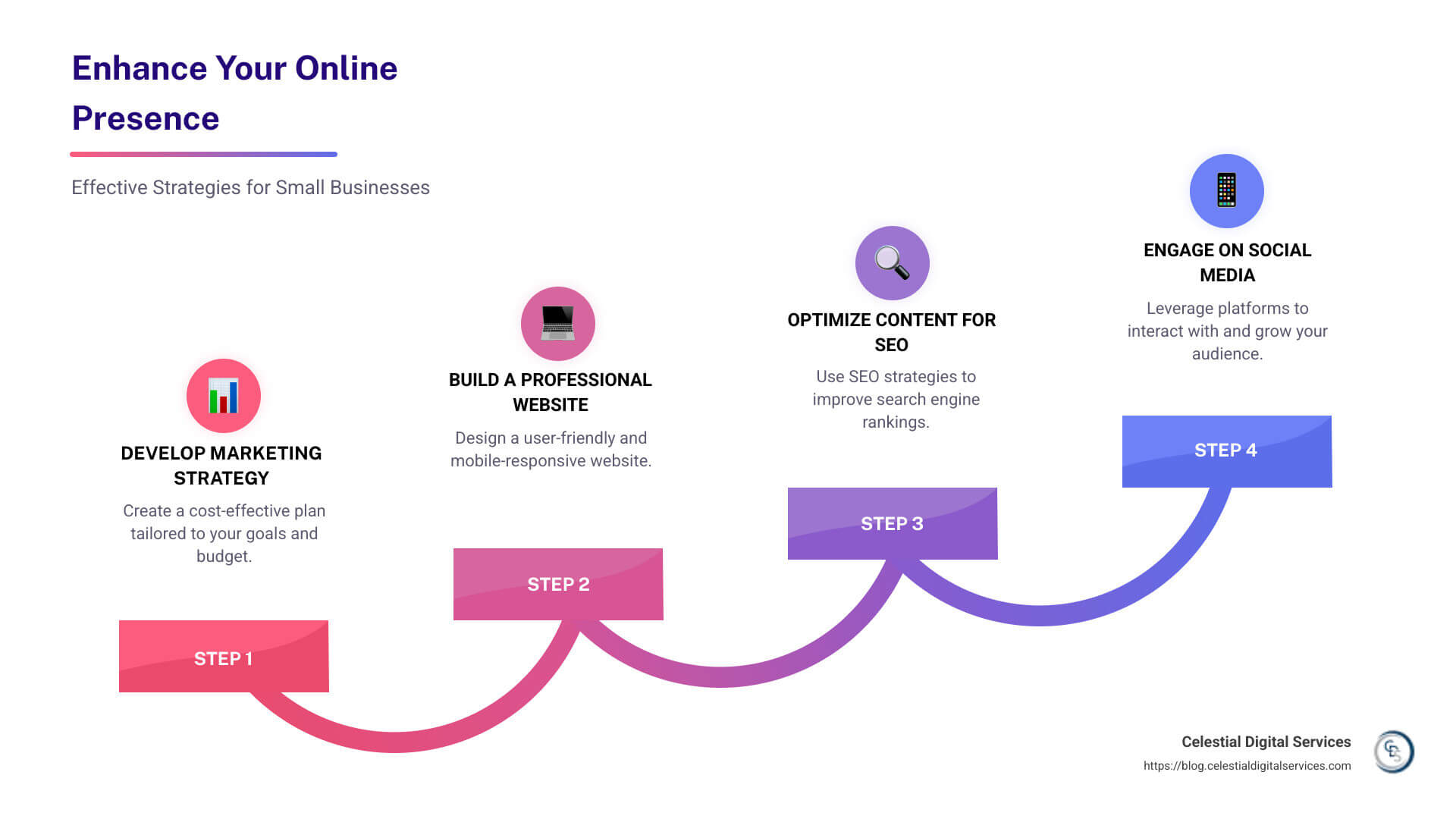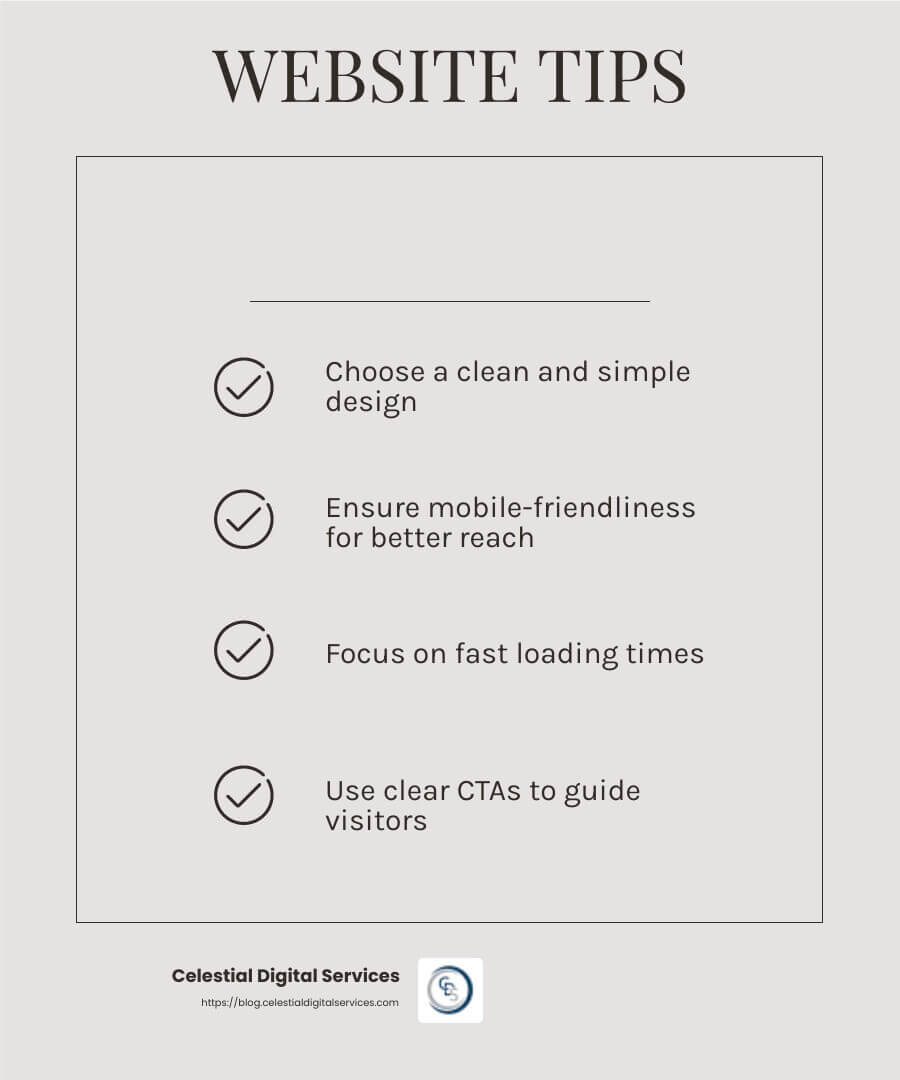Online presence improvement is essential for small businesses aiming to thrive in today’s digital-centric world. To boost your online visibility quickly, consider focusing on these key strategies:
- Develop a cost-effective marketing strategy custom to your goals and budget.
- Build a professional website that is user-friendly and mobile-responsive.
- Create SEO-optimized content to attract visitors and improve search engine rankings.
- Leverage social media platforms to engage and expand your audience.
- Use email marketing for personalized and segmented outreach.
- Monitor your progress using tools like Google Analytics and adjust your tactics as needed.

Develop a Cost-Effective Online Marketing Strategy
Creating a cost-effective marketing strategy is vital for enhancing your online presence without breaking the bank. Here’s how to do it efficiently:
Set Clear Goals
Start by defining what you want to achieve. Are you looking to increase website traffic, generate more leads, or boost sales? Setting SMART (Specific, Measurable, Achievable, Relevant, Time-bound) goals helps keep your marketing efforts focused and effective.
Budget Wisely
Allocate your budget based on your goals and the channels that best reach your audience. It’s important to balance between free strategies, like organic social media, and paid ones, like targeted ads. A well-planned budget can maximize your reach without overspending.
Choose the Right Channels
Identify where your audience spends most of their time online. Popular channels include social media, email marketing, and search engines. For instance, social media is crucial as it’s used by 99% of mobile users, according to a study by Sprout Social.
Use Free Tools
Take advantage of free tools to improve your strategy. Tools like Google My Business can improve your local visibility. Also, use Google’s Page Speed Insights to optimize your website’s performance.
Create Engaging Content
Content is king. Develop content that speaks directly to your audience’s needs and interests. Use SEO techniques, like keyword optimization, to ensure your content ranks well in search results.
Measure and Adjust
Regularly monitor your progress. Use tools like Google Analytics to track your performance against your goals. Adjust your strategies based on what works and what doesn’t. Continuous improvement is key to maintaining a strong online presence.
By following these steps, you can build a robust and cost-effective marketing strategy that improves your online presence. Next, let’s dive into building a professional website that draws in and retains visitors.
Build a Professional Website
Creating a professional website is a cornerstone of online presence improvement. Your website is often the first impression potential customers have of your business, so it needs to be both attractive and functional.
Website Design
Your website design should reflect your brand. Use colors, fonts, and styles that align with your business identity. A clean and simple design is often more effective than one that is overly complex. Keep navigation straightforward so visitors can easily find what they need. A well-designed website builds trust and encourages users to stay longer.
Mobile-Friendly
With over 60% of internet searches happening on mobile devices, having a mobile-friendly website is essential. Google uses mobile-first indexing, meaning it primarily looks at the mobile version of your site to determine its ranking. Ensure your site is responsive, meaning it automatically adjusts to fit different screen sizes. This not only improves user experience but also helps your site rank better in search results.
User-Friendly
A user-friendly website is intuitive and easy to steer. Here are a few tips to improve usability:
- Fast Loading Times: Use tools like Google’s Page Speed Insights to check and improve your site’s speed. Slow sites can frustrate users and drive them away.
- Clear Calls to Action (CTAs): Make it easy for visitors to know what to do next, whether it’s contacting you, purchasing a product, or signing up for a newsletter.
- Accessible Information: Ensure important details like contact info and business hours are easy to find. A search bar can help users quickly locate specific content.

By focusing on these elements, you can create a professional website that not only attracts visitors but also keeps them engaged. This is a critical step in building a strong online presence that supports your business goals. Now, let’s explore how to create and optimize content for SEO to further improve your visibility.
Create and Optimize Content for SEO
Creating quality content is a key factor in online presence improvement. When you produce content that resonates with your audience, you’re not just sharing information; you’re building a connection. This connection can lead to increased visibility and engagement.
Content Creation
Start with understanding your audience. What are their interests and pain points? Your content should address these directly. Use a variety of formats like blog posts, videos, infographics, and podcasts to keep your audience engaged.
A study shows that businesses that blog four times a week receive 3.5 times more traffic than those that blog less frequently. Consistency is crucial.
Keywords
Keywords are the bridge between what people are searching for and the content you provide. Use tools like Google Keyword Planner or Ahrefs to find relevant keywords for your industry.
Once you’ve identified the right keywords, incorporate them naturally into your content. Keywords should appear in your titles, headers, and throughout your text, but avoid keyword stuffing. Aim for a seamless integration that improves readability.
SEO Best Practices
To optimize your content for search engines, follow these best practices:
- Content Freshness: Regularly update your content to keep it relevant. This not only appeals to your audience but also helps improve your ranking in search results.
- Internal Linking: Use internal links to guide visitors to other relevant parts of your website. This keeps them engaged and helps search engines understand your site structure.
- Technical SEO: Ensure your website is technically sound. This includes optimizing your site’s speed, mobile readiness, and fixing any broken links.
By focusing on these strategies, you can create content that not only attracts visitors but also ranks well in search engines. This is a powerful way to boost your online presence improvement efforts. Next, we’ll dive into leveraging social media for engagement.
Leverage Social Media for Engagement
Social media is a powerful tool for online presence improvement. It allows you to interact with your audience directly and build a community around your brand. Here’s how you can make the most of it:
Choose the Right Platforms
Not all social media platforms are created equal. Identify where your audience spends most of their time. For example, Instagram is great for visual content, while LinkedIn is ideal for professional networking. Focus your efforts on the platforms that align with your brand and audience.
Create Engaging Content
The key to social media success is engagement. Create content that encourages likes, comments, and shares. Use a mix of text, images, and videos to keep things interesting.
Interactive content like polls, quizzes, and Q&A sessions can significantly boost engagement. For instance, hosting a live Q&A session can help you connect with your audience in real-time, making your social media presence more dynamic.
Use Hashtags and Keywords
Just like SEO for websites, using the right hashtags and keywords can increase your visibility on social media. Research trending hashtags in your industry and incorporate them into your posts.
But remember, quality over quantity. Use relevant hashtags that are specific to your content rather than overly broad ones.
Consistent Posting Schedule
Consistency is crucial. Develop a posting schedule to keep your audience engaged. Tools like Hootsuite or Buffer can help you plan and schedule your posts in advance.
According to research, businesses that post consistently on social media see higher engagement rates compared to those that post sporadically.
Engage with Your Audience
Social media is not just about broadcasting your message; it’s about interaction. Respond to comments, answer questions, and engage with your followers’ content.
Building relationships with your audience fosters loyalty and trust. It also humanizes your brand, making it more relatable.
Collaborate with Influencers
Partnering with influencers in your niche can expand your reach. Influencers already have a dedicated following, and their endorsement can introduce your brand to new audiences.
Choose influencers whose values align with your brand for authentic collaborations.
By leveraging social media effectively, you can improve engagement and strengthen your online presence. This not only boosts visibility but also builds a loyal community around your brand. Next, we’ll explore how to use email marketing to further connect with your audience.
Use Email Marketing
Email marketing is a cost-effective way to improve your online presence and build stronger relationships with your audience. Here’s how you can make the most of it:
Segment Your Audience
Segmentation is key to effective email marketing. By dividing your email list into smaller groups based on characteristics like age, location, or interests, you can send more relevant messages.
Imagine you run a bookstore. You could segment your list into fiction lovers, non-fiction enthusiasts, and children’s book fans. This way, each group receives content that truly interests them, increasing the chances of engagement.
Personalize Your Emails
Personalization goes beyond just adding a recipient’s name. It involves tailoring content to meet the specific needs and preferences of your audience.
For example, if a customer previously purchased a mystery novel, you might send them recommendations for similar books. Personalized emails show your audience that you understand them, which builds trust and encourages loyalty.
Craft Engaging Subject Lines
The subject line is the first thing your audience sees. Make it catchy and concise to encourage opens. Effective subject lines are typically under 50 characters, ensuring they don’t get cut off on mobile devices.
A subject line like “Open up Exclusive Discounts Just for You, [Name]!” can grab attention and entice the recipient to click.
Provide Valuable Content
Ensure your emails provide value. This could be in the form of tips, exclusive offers, or updates about new products. Valuable content keeps your audience engaged and more likely to look forward to your emails.
For instance, a monthly newsletter with industry insights or special promotions can keep your brand top-of-mind without overwhelming your audience.
Monitor and Optimize
Use analytics to track the success of your email campaigns. Metrics like open rates, click-through rates, and conversions can provide insights into what’s working and what needs improvement.
Experiment with A/B testing to see which elements resonate best with your audience. This could involve testing different subject lines, layouts, or call-to-action buttons.
By leveraging email marketing with segmentation and personalization, you can create meaningful connections with your audience and improve your online presence. Next, we’ll explore how to monitor and adjust your strategy for continuous improvement.
Monitor and Adjust Your Strategy
Once you’ve implemented your online marketing efforts, it’s crucial to keep an eye on how they’re performing. Regular monitoring allows you to see what’s working and what needs to change. This is where progress tracking tools like Google Analytics come into play.
Track Your Progress
Google Analytics is a powerful tool that helps you understand your website’s performance. It provides insights into your site’s traffic, user behavior, and conversion rates. You can see where your visitors are coming from, which pages they’re visiting, and how long they stay.
Imagine you’re running a small bakery. You notice a spike in traffic after posting a new blog about cake decorating tips. This tells you that your audience is interested in this topic, and you can create more similar content to keep them engaged.
Identify Areas for Improvement
By analyzing the data, you can identify areas that need improvement. For instance, if you see a high bounce rate on a particular page, it might mean that the content isn’t engaging or relevant enough. You can then work on making the content more appealing or user-friendly.
Consider using A/B testing to refine your strategy. This involves creating two versions of a webpage or email to see which one performs better. You might test different headlines, images, or call-to-action buttons to find the most effective combination.
Make Data-Driven Decisions
Use the insights gained from your analytics to make informed decisions. If a certain type of content or social media post is performing well, focus more on that area. If a marketing campaign isn’t delivering results, tweak your approach or try something new.
For example, if your email open rates are low, experiment with different subject lines or sending times to see what resonates best with your audience.
Schedule Regular Reviews
Set a regular schedule to review your analytics and adjust your strategy accordingly. This could be weekly or monthly, depending on your business needs. Regular reviews ensure that you’re staying on track and making the most of your online marketing efforts.
By consistently monitoring and adjusting your strategy, you can improve your online presence and achieve better results over time. This approach not only helps you stay competitive but also ensures you’re meeting the evolving needs of your audience.
Next, we’ll address some frequently asked questions about improving your online presence.
Frequently Asked Questions about Online Presence Improvement
How do I improve my online presence?
Improving your online presence involves a mix of strategies aimed at increasing your digital visibility. Start by creating a comprehensive online marketing strategy. Set clear goals and allocate a budget to guide your efforts. Focus on building a professional, user-friendly website that reflects your brand and is optimized for mobile devices.
Next, create high-quality content that is optimized for search engines (SEO). This involves using relevant keywords that your audience is searching for. Regularly update your content to keep it fresh and engaging. Don’t forget to leverage social media platforms to engage with your audience and build relationships.
What are the core elements of an online presence?
The core elements of an online presence include a well-designed website, effective SEO, and engaging content. Your website should be easy to steer and mobile-friendly, as more than half of internet searches are performed on mobile devices. Ensure your site loads quickly and is visually appealing.
SEO is crucial for making your content findable. Use tools like Google Keyword Planner to identify popular search terms and incorporate them into your content. Regularly update your site to maintain a high ranking in search engine results.
Engaging content is key to attracting and retaining visitors. Whether it’s blog posts, videos, or social media updates, make sure your content is relevant and valuable to your audience.
How can I build a positive online presence?
Building a positive online presence involves creating content that resonates with your audience and encourages interaction. Focus on positive content that showcases your brand’s values and expertise. Share success stories, customer testimonials, and useful tips that position your business as a trusted resource.
Engagement is also critical. Respond to comments on your blog and social media channels. Encourage discussions and ask for feedback to foster a sense of community. This not only improves your reputation but also increases your visibility as more people interact with your content.
By implementing these strategies, you can improve your online presence and connect more effectively with your audience.
Conclusion
At Celestial Digital Services, we understand the challenges small businesses face in the digital age. Our mission is to empower these enterprises with digital solutions that are both innovative and accessible.
We offer a comprehensive suite of services custom to improve your online presence. From SEO and lead generation to social media marketing and AI-based tools, our goal is to simplify digital marketing for businesses that may not have a technical background. We believe that every business, regardless of size, deserves the opportunity to thrive online.
By partnering with us, you can expect personalized strategies that align with your unique goals. Our team is committed to providing exceptional service and delivering measurable results. Whether you’re looking to improve your website, engage with your audience on social media, or optimize your content for search engines, we’re here to guide you every step of the way.
Ready to take your online presence to the next level? Visit our blog for more insights and find how Celestial Digital Services can help your small business stand out in the competitive online landscape.



